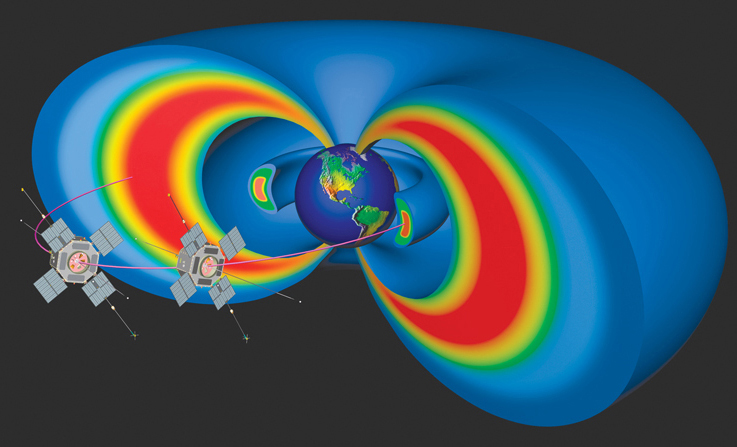Braving the Storm
IN 2012, NASA WILL LAUNCH TWO SPACECRAFT into Earth’s radiation belts to brave the harsh environment and probe its inner workings as never before. Onboard each of the
identical twins will be a computer built in the Space Science Center.
The Radiation Belt Storm Probes will explore the two donut-shaped regions of high-energy particles trapped by the magnetic field of the Earth. The radiation belts are often referred to as the “Van Allen Belts” due to their discovery by James Van Allen and his team at the University of Iowa in 1958.
Fittingly, the University of Iowa is one of four lead institutions for the mission. Professor Craig Kletzing, a former research associate professor at UNH, is leading the Iowa team in the Electric and Magnetic Field Instrument Suite and Integrated Science experiment.
Partnering with Kletzing’s group are professor Roy Torbert, UNH co-investigator for the mission (and Kletzing’s former research advisor), software engineer Jerry Needell, digital engineer David Bodet, research project engineer Jon Googins, and project manager Jim Tyler.
The mission will provide unprecedented insight into the physical dynamics of the radiation belts and give scientists the data needed to make predictions of changes in this critical region of space – the region where “space weather” occurs and where hundreds of spacecraft operate.
The term space weather generally refers to conditions on the Sun, in the solar wind, and within Earth’s magnetosphere and upper atmosphere that can influence the performance and reliability of space-borne and ground-based technological systems and can endanger human life or health.
Besides emitting a continuous stream of plasma (solar wind), the Sun periodically releases billions of tons of matter via coronal mass ejections. These immense clouds of material, when directed towards Earth, can cause large magnetic storms in the space environment around Earth, the magnetosphere, and the upper atmosphere.
The two radiation belt probes will measure the particles, magnetic and electric fields, and waves that fill the region of space surrounding Earth or “geospace.” Only with two spacecraft taking identical measurements and following the same path can scientists begin to understand how the belts change in both space and time.
Says Torbert, “The RBSP mission will greatly advance our understanding of the dynamics of the radiation around the Earth, making significant improvements in what the science community learned in the last mission to this region, the Combined Release and Radiation Effects Satellite mission launched in 1990.”
Most spacecraft in Earth’s orbit operate partly or entirely within the radiation belts. During periods of intense space weather the density and energy of the trapped particles can increase, posing a danger to astronauts, spacecraft, and even some ground-based technologies.
Modern society relies on more than 800 satellites for communication and navigation and increasingly complex systems to power activities on Earth. Understanding the radiation belts and the dangers they pose to technologies will help engineer better ways to protect them.
But first, the data must be gathered, and a critical component in that process will be the UNH-built computer that will be tasked with coordinating the timing of the onboard field and wave experiments and “packaging” the data for transmission back to Earth.
Software engineer Jerry Needell says his biggest challenge for the mission is writing “bulletproof” code that is both robust and can also be reprogrammed as data comes in and the mission evolves.
Explains Needell, “After analyzing some of the findings, scientists might understand some things better and want to take a different tack to improve the mission. So we need to provide the capability to reprogram the operational science software on the fly.”
Needell notes that another hurdle to overcome is being able to transmit the plethora of data gathered back down to Earth through the “very small pipe” of telemetry.
“We collect data much faster than it can be transmitted to the ground so you have to be selective about what you send,” Needell says. To achieve this, the onboard computer must perform some data analysis but, Needell notes, “The drawback is that the original data is never sent to the ground, so if the analysis is flawed, the data cannot be recovered.”
Kletzing notes that through the combined expertise of UNH in flight computers, Iowa in wave measurements, and NASA’s Goddard Space Flight Center in magnetometers, “We will be able to optimize what we send to the ground and get the biggest scientific ‘bang for the buck’. These will be the best measurements in the radiation belts ever achieved, which makes for a very exciting mission.”
The $550 million, two-spacecraft project is part of NASA’s Living With a Star Geospace program to explore fundamental processes that operate throughout the solar system, in particular those that generate hazardous space weather effects near the Earth and phenomena that could affect solar system exploration.
Artist's conception of RBSP satellite.
Image courtesy of Johns Hopkins University Applied Physics Laboratory |
The Radiation Belt Storm Probes will explore the two donut-shaped regions of high-energy particles trapped by the magnetic field of the Earth. The radiation belts are often referred to as the “Van Allen Belts” due to their discovery by James Van Allen and his team at the University of Iowa in 1958.
Fittingly, the University of Iowa is one of four lead institutions for the mission. Professor Craig Kletzing, a former research associate professor at UNH, is leading the Iowa team in the Electric and Magnetic Field Instrument Suite and Integrated Science experiment.
Partnering with Kletzing’s group are professor Roy Torbert, UNH co-investigator for the mission (and Kletzing’s former research advisor), software engineer Jerry Needell, digital engineer David Bodet, research project engineer Jon Googins, and project manager Jim Tyler.
The mission will provide unprecedented insight into the physical dynamics of the radiation belts and give scientists the data needed to make predictions of changes in this critical region of space – the region where “space weather” occurs and where hundreds of spacecraft operate.
The term space weather generally refers to conditions on the Sun, in the solar wind, and within Earth’s magnetosphere and upper atmosphere that can influence the performance and reliability of space-borne and ground-based technological systems and can endanger human life or health.
Besides emitting a continuous stream of plasma (solar wind), the Sun periodically releases billions of tons of matter via coronal mass ejections. These immense clouds of material, when directed towards Earth, can cause large magnetic storms in the space environment around Earth, the magnetosphere, and the upper atmosphere.
The two radiation belt probes will measure the particles, magnetic and electric fields, and waves that fill the region of space surrounding Earth or “geospace.” Only with two spacecraft taking identical measurements and following the same path can scientists begin to understand how the belts change in both space and time.
Says Torbert, “The RBSP mission will greatly advance our understanding of the dynamics of the radiation around the Earth, making significant improvements in what the science community learned in the last mission to this region, the Combined Release and Radiation Effects Satellite mission launched in 1990.”
Most spacecraft in Earth’s orbit operate partly or entirely within the radiation belts. During periods of intense space weather the density and energy of the trapped particles can increase, posing a danger to astronauts, spacecraft, and even some ground-based technologies.
Modern society relies on more than 800 satellites for communication and navigation and increasingly complex systems to power activities on Earth. Understanding the radiation belts and the dangers they pose to technologies will help engineer better ways to protect them.
But first, the data must be gathered, and a critical component in that process will be the UNH-built computer that will be tasked with coordinating the timing of the onboard field and wave experiments and “packaging” the data for transmission back to Earth.
Software engineer Jerry Needell says his biggest challenge for the mission is writing “bulletproof” code that is both robust and can also be reprogrammed as data comes in and the mission evolves.
Explains Needell, “After analyzing some of the findings, scientists might understand some things better and want to take a different tack to improve the mission. So we need to provide the capability to reprogram the operational science software on the fly.”
Needell notes that another hurdle to overcome is being able to transmit the plethora of data gathered back down to Earth through the “very small pipe” of telemetry.
“We collect data much faster than it can be transmitted to the ground so you have to be selective about what you send,” Needell says. To achieve this, the onboard computer must perform some data analysis but, Needell notes, “The drawback is that the original data is never sent to the ground, so if the analysis is flawed, the data cannot be recovered.”
Kletzing notes that through the combined expertise of UNH in flight computers, Iowa in wave measurements, and NASA’s Goddard Space Flight Center in magnetometers, “We will be able to optimize what we send to the ground and get the biggest scientific ‘bang for the buck’. These will be the best measurements in the radiation belts ever achieved, which makes for a very exciting mission.”
The $550 million, two-spacecraft project is part of NASA’s Living With a Star Geospace program to explore fundamental processes that operate throughout the solar system, in particular those that generate hazardous space weather effects near the Earth and phenomena that could affect solar system exploration.
by David Sims, Science Writer, Institute for the Study of Earth, Oceans, and Space. Published in Winter 2009 issue of EOS .

